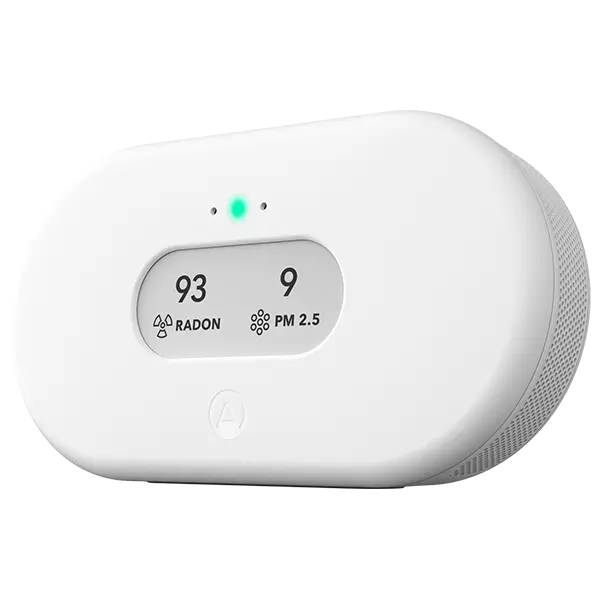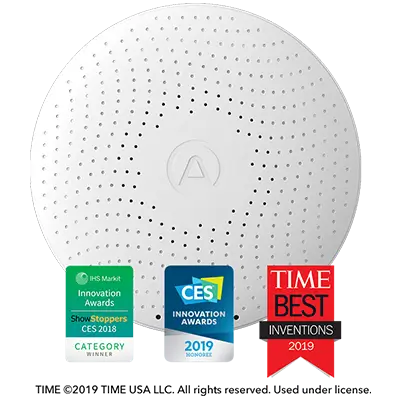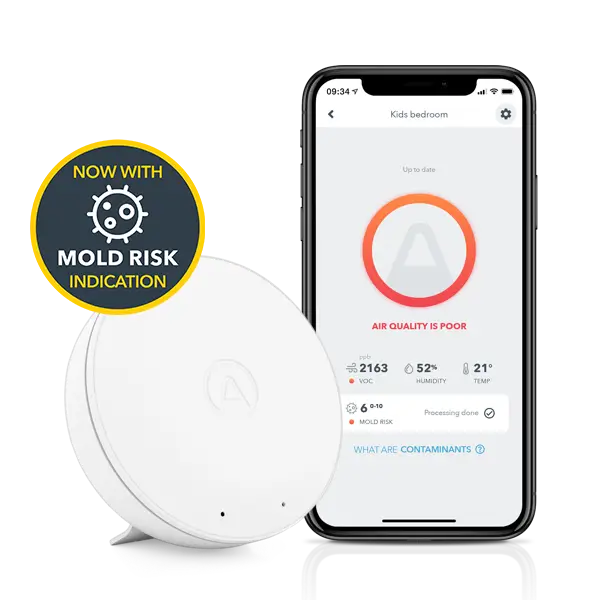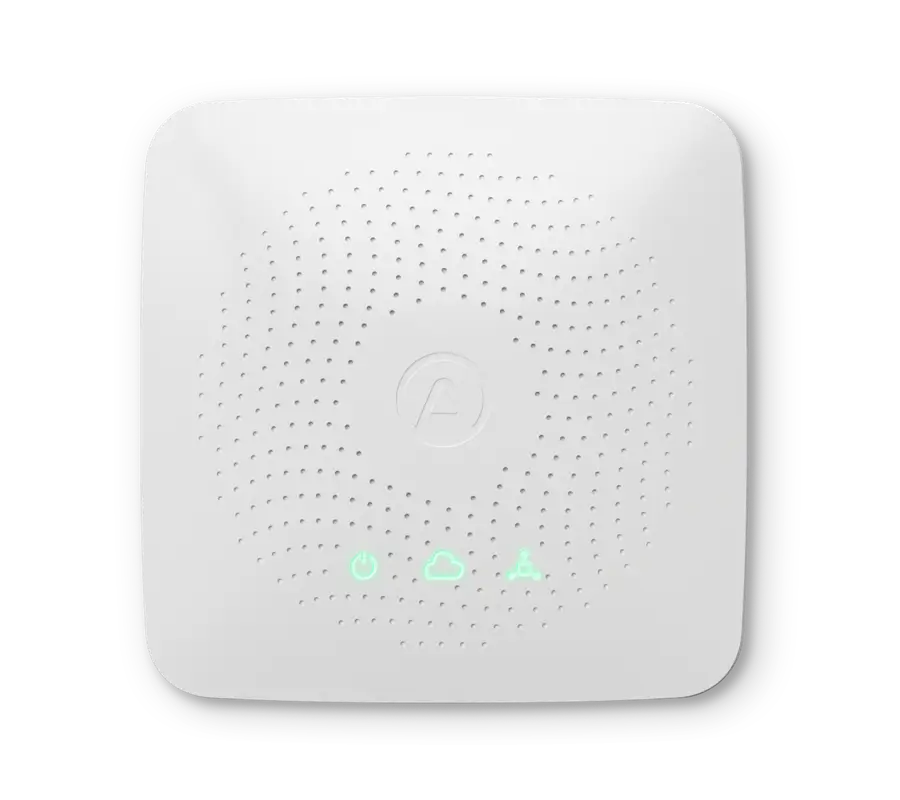Indoor air quality in your vacation home could be suffering while it’s not being used. Keep it welcoming and healthy all year round by monitoring indoor air remotely.
In this blog
- As fresh as if you’d never left
- Mold and mildew
- Dust and particulate matter (PM)
- Airborne chemicals
- Radon
- Peace of mind when you’re not around
As fresh as if you'd never left
It’s your home away from home. Your retreat from work and stress. It means holiday time, but with all the comforts and familiarity you expect from a second property.
Except… vacation homes can be at risk from problems because they’re often used infrequently. You arrive for the holiday season and find things are not as they should be. Patches of damp perhaps, mold or mildew in certain areas, a musty atmosphere or unfamiliar odors.
Many of these issues can be explained because indoor air quality for second homes tends to deteriorate when you’re not about. But by monitoring indoor air quality in your vacation home, you can identify any issues, put them right, and ensure that your property always feels just the way you left it.
Mold and mildew
If you leave your holiday home unoccupied over winter or for any long period of time, you’re unlikely to keep the heating running. That means the property may be susceptible to damp, which, in turn, creates conditions where mold and mildew thrive.
Mold and mildew spores exist everywhere, including in the air, but usually we don’t notice them and they don’t do any harm. When the conditions are right, though, they settle on surfaces and grow, creating black or green patches of mold, or white and grey mildew1.
These problems are likely to affect properties located in more humid climates. When relative humidity regularly tops 60%, the water vapor in the air supplies the levels of moisture that mold needs to grow2.
On the other hand, in colder climates, damp can get inside your building. Warmer air from indoors hits colder walls, creating condensation and a perfect environment for unsightly growths.
You can tackle potential issues with mold and mildew by monitoring relative humidity in your property and keeping it at recommended levels (ideally between 30-50%)3. Keeping the temperature in your holiday home relatively consistent, by using a thermostat and running the heating regularly, should help too.
In addition, effective ventilation and dehumidifiers are a great way to discourage mold growth. Make sure, too, that you use mold resistant paints in potential problem areas, like bathrooms, kitchens, and basements4.
Still have more questions? Learn everything you need to know about mold in your home here.
Dust and particulate matter (PM)
Particulate matter, or PM, is made up of tiny particles of dust, dirt, and liquids that become suspended in the air. Some of these are large enough to see, like smoke, smog, or soot, but the most harmful are smaller, invisible particles5.
Fine particles are created by both man-made and natural sources. Some of the PM you breathe in your holiday home will have made its way indoors from outside. Other particles are generated by activities like cooking, burning fuel or candles, unvented heaters, and smoking. While yet more come from biological sources, like mold and mildew, or dust6.
When a vacation home isn’t being used, cleaned, or ventilated regularly, the PM can build up, causing problems with asthma and allergies when you return. Fine particles inflame the respiratory system and irritate the eyes, ears, nose, and throat. They can trigger allergies like hay fever7.
Over the longer term, PM is associated with serious complaints like congestive heart failure, coronary artery disease, and the lung condition called chronic obstructive pulmonary disease (COPD)8.
To avoid triggering allergies or asthma when you arrive back at your holiday home, or simply to make that big clean a less unpleasant experience, it may be worth organizing regular maintenance to avoid dust and other particles accumulating while you’re away.
You should be aware too that PM varies from location to location. A lot of fine particles, whether they’re made up of pollen or carbon from engines, can enter the home from outside. If you monitor PM levels in the area, you’ll be able to take timely action to prevent higher concentrations in your property.
Still have more questions? Learn everything you need to know about PM in your home here.
Airborne chemicals
Airborne chemicals, or VOCs, are contained in lots of common household items, including cleaning products, paints, solvents, varnishes, carpets, furniture, wallpapers, and mattresses. They’re emitted as odorous gases and can build up in the air we breathe9.
You may have heard of some common examples without hearing these specific terms used10. They include formaldehyde, which is used in glues, fabrics, and household fuels, benzene, found in building products, heating oil, and cigarette smoke11, and acetone, contained in polishes, upholstery, and nail varnish remover12.
If your vacation home is newly built, high levels of airborne chemicals are particularly likely. That brand new smell may have good associations, but it can be a sign that carpets, floors, building materials, or paint are ‘off-gassing’ VOCs13. The same is true if you’ve redecorated or added new furniture.
This problem can be compounded in vacation homes that are often closed up for security or left unused for lengthy periods, with the result that they may be poorly ventilated.
To mitigate these effects, ventilate the property thoroughly each time you use it, by opening the windows, deploying ventilation systems, and cranking up any fans. In addition, if it’s possible to arrange regular maintenance visits, put airing out your home on the ‘to-do list’.
It’s worth remembering too that many low-VOC alternatives are available when you’re shopping or sourcing materials. Sometimes they’re marketed as ‘low odor’ products.
Still have more questions? Learn everything you need to know about VOCs in your home here.
Radon gas
Radon is a colorless, odorless, radioactive gas that is emitted naturally by rocks and soil beneath our feet. In the open air the gas is only present in tiny concentrations, but when it seeps into buildings it can build up to dangerous levels, particularly in basements or lower storeys14.
When radon accumulates indoors, it forms a fine, radioactive dust that can become trapped in our airways when we breathe. Inhaling the gas increases the risk of lung cancer and radon is the biggest cause of the disease in non-smokers. It causes 21,00015 deaths per year in the US and 20,000 in the EU16.
If your holiday home is in an area where levels of radon are high, there may be a greater risk of problems arising, because of factors like infrequent ventilation. The prevalence of the gas varies from region to region, depending on geology. If you live in the US, you can check how your vacation home is likely to be affected here, while there is a similar map for Europe here.
You can get an accurate picture of radon in your property by monitoring for the gas. If there are problems, you may need to improve ventilation, especially if you have a basement, or a ground floor.
Still have more questions? Learn everything you need to know about radon in your home here.
Peace of mind when you’re not around
Sadly, you can’t always be at your vacation home, but there is a way to keep track of potential air quality issues remotely. Airthings indoor air quality monitors measure all the key pollutants and conditions, providing real-time and historical data, so that you always have an accurate picture of the air in your holiday property, whether you’re there or not.
The sensors use long-life batteries and wireless technology, so they’re easy to get up and running without any tricky or time-consuming setup process. The ‘Airthings hub’ brings the information from the Airthings indoor air quality monitors online and displays it in one place, which you can access from anywhere via the handy mobile app.
That means you always have all the information about the indoor air quality in your vacation home at your fingertips, on your laptop, cellphone, or tablet, wherever you are in the world. Armed with this data, you can take action quickly if any problems arise or schedule maintenance to prevent any potential damage.
An indoor air quality monitoring system, such as the Airthings House Kit, will help ensure your vacation home is welcoming and healthy, every time you arrive for a break.
Key takeaways
- Vacation homes can be at particular risk of indoor air quality issues because they’re often used infrequently and may be shut-up for periods without adequate ventilation.
- Mold and mildew is a risk, particularly in humid or colder climates. Keeping relative humidity below 60% is advised to combat these problems.
- Dust and particulate matter (PM) tend to accumulate when you’re away from your vacation home.
- Airborne chemicals and radon are health-damaging pollutants that can build-up when ventilation is infrequent.
- You can’t always be at your vacation home, but you can access all the information about its indoor air quality remotely by installing Airthings indoor air quality monitors.
Sources:
1. .epa.gov/mold/what-difference-between-mold-and-mildew
2. .epa.gov/mold/mold-course-chapter-2
3. epa.gov/mold/mold-course-chapter-2#Chapter2Lesson3
4. whatpaint.co.uk/by-type/anti-mould
5. blf.org.uk/support-for-you/air-pollution/types
6. epa.gov/indoor-air-quality-iaq/indoor-particulate-matter
7. sciencedirect.com/science/article/pii/S0954611115001870
8. ncbi.nlm.nih.gov/pmc/articles/PMC6250783/
9. epa.gov/indoor-air-quality-iaq/what-are-volatile-organic-compounds-vocs
10. .atsdr.cdc.gov/formaldehyde/home/index.html
11. who.int/ipcs/features/benzene.pdf
12. webmd.com/diet/what-is-acetone#1
13. indoorscience.com/blog/vocs-new-construction/
14. who.int/news-room/fact-sheets/detail/radon-and-health
15. epa.gov/radon/health-risk-radon
16. ec.europa.eu/commission/presscorner/detail/en/IP_04_1539










.webp)



%20(1).webp)

%20(1).webp)
